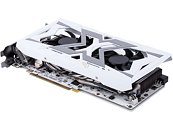
DATALAND Introduces White Version of the RX 580 X-Serial
DATALAND is a little known manufacturer of graphics cards and subsidiary of TUL Corporation (of PowerColor fame). While PowerColor graphics cards have hit our review stand with varying levels of success, DATALAND's particular interpretations of AMD's Radeon GPUs have never graced our shores. The white version of the RX 580 X-Serial doesn't simply break a drought of AMD Radeon 500 series announcements (not all that strange, considering the cards have been out for months now). As its parent company was founded in 1999, DATALAND has seen it fit to introduce a commemorative, 18th Anniversary model of the RX 580 graphics card. And that's what this graphics card is all about.
Besides the fact that it's a white version of the company's red and black RX 580 X-Serial design, there doesn't seem to be much to write home about here. The core clocks have seen a small bump from the RX 580 X-Serial version from 1355 MHz up to 1380 MHz, and that's about it. That said, this is a very interesting color scheme for an AMD Radeon graphics card, and a design that red team users were being somewhat left out of by AMD's AIB partners. So if you have an arctic white color scheme in your build, and wanted to have an AMD-powered, FreeSync-enabled GPU to match, this might be it. You can even count on 1x DVI in addition to the more standard 1x HDMI and 3x DisplayPort display outputs, though whether that's a feature nowadays is debatable.
Besides the fact that it's a white version of the company's red and black RX 580 X-Serial design, there doesn't seem to be much to write home about here. The core clocks have seen a small bump from the RX 580 X-Serial version from 1355 MHz up to 1380 MHz, and that's about it. That said, this is a very interesting color scheme for an AMD Radeon graphics card, and a design that red team users were being somewhat left out of by AMD's AIB partners. So if you have an arctic white color scheme in your build, and wanted to have an AMD-powered, FreeSync-enabled GPU to match, this might be it. You can even count on 1x DVI in addition to the more standard 1x HDMI and 3x DisplayPort display outputs, though whether that's a feature nowadays is debatable.



